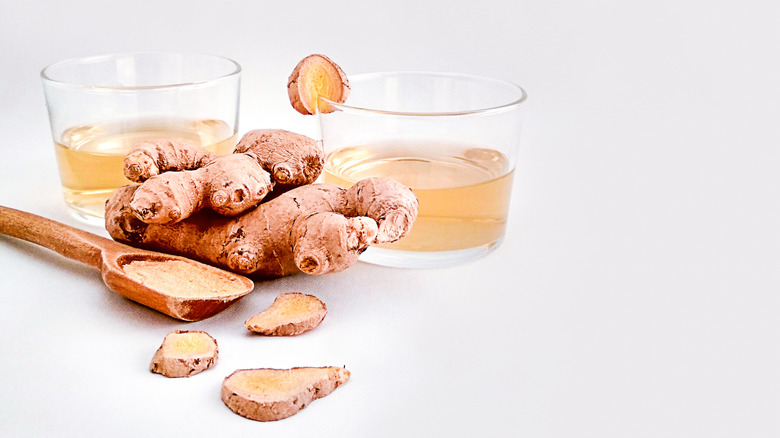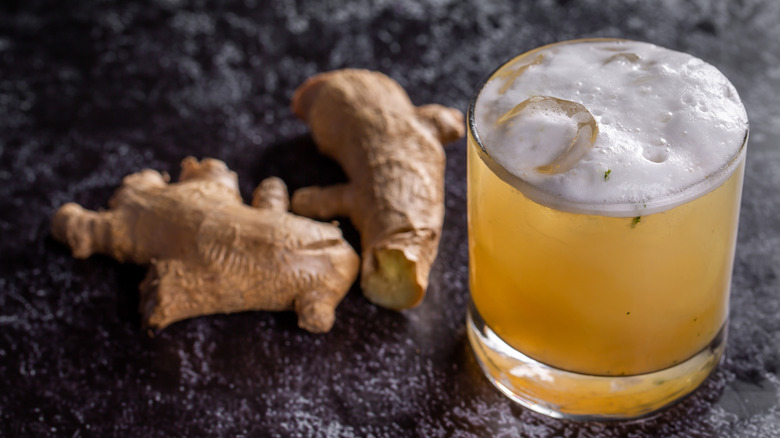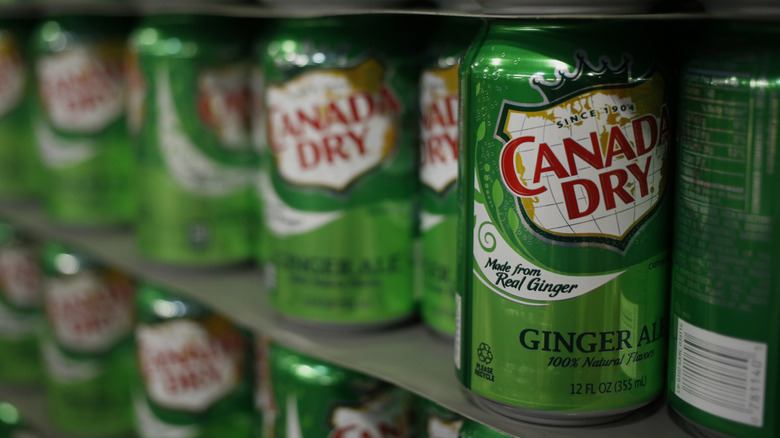Golden Vs. Dry Style Ginger Ale: What's The Difference?
There is an element of satisfaction that comes with pulling a cold can of soda from the fridge, cracking open the tab with one quick move, and listening to the sigh of the carbonation as it echoes through the room. That's the pre-drinking experience people crave when they open up a can of ginger ale. Ginger ale, if it isn't made obvious by the name, is flavored with ginger spice, giving the drink a warm, toasty flavor that pairs well with the intense sweetness. Britannica says that while ginger ale used to go through a fermentation process much like that of champagne to obtain carbonation, a majority of brands now infuse their bottles with carbon dioxide gas.
A lot of people drink ginger ale because they enjoy the beverage's spice, but others gravitate towards it because of the health benefits that come with ginger. Grandparents will often prescribe ginger ale to their grandchildren if they complain about stomachaches, headaches, or nausea with good intentions, and sometimes the placebo works, but Healthline claims that while some ginger ale brands contain some significant ginger, most have only a small amount of ginger in them. In addition, most ginger ales have so much sweetener in them that the drink is more likely to give you a sugar rush than alleviate indigestion. Regardless, ginger ale is a widely popular drink, not just solo, but as a mixer for cocktails such as a Moscow mule or a Dirty Shirley, but what if we told you that there wasn't just one kind of ginger ale?
Golden ginger ale
Golden ginger ale is perhaps the oldest kind of ginger ale made, but it shouldn't be mistaken for ginger beer, which is produced differently, is cloudier (because of the brewing process), and is a bit older than the invention of the ale (via Masterclass). Golden ginger ale has a name as effervescent as its taste. It's marked by its sweet taste coupled with a strong ginger flavor.
According to Moscow Muled, the first recorded ginger ale was produced in the 19th century by an Irishman named Thomas Joseph Cantrell. He was an apothecary and surgeon in Belfast, Northern Ireland during the 1850s and created a non-alcoholic, golden-colored, sweet drink that was characterized by its intense ginger flavor. Cantrell worked with Grattan and Company to make the first original ginger ale (per Just Fun Facts).
Golden ginger ale is less common and less widespread today, though it's more popular in certain regions and certain brands have strong followings. Some notable modern golden ginger ale brands are Vernors, Blenheim, A-Treat, Bull's Head, Chelmsford, Buffalo Rock, Red Rock, and Sussex, one of the oldest ginger ale brands in the world.
Dry style ginger ale
While golden ginger ale is characterized by the intensity of its ginger flavor and sweetness, not every customer enjoyed how powerful the drink was. Dry style ginger ale (aka pale-style) was made well after the invention of golden ginger ale, and is paler, less sweet, and has a less intense ginger flavor (per Atlantic Business Magazine). According to Canada Dry, the majority of ginger ale we drink today is actually dry style ginger ale, not gold, and that's thanks to the brand's founder, John J. McLaughlin. He founded his company in 1904, setting up a business to perfectly fill a niche that was about to be created by the United States government a few years later thanks to prohibition: non-alcoholic sparkling drinks that could be drunk on their own or used to cover the taste of the bootleg liquor made at the time.
Dry style ginger ale may have even been inspired by French Champagne and became a popular replacement for the wine in many drinks; Canada Dry says the brand was called "the champagne of soda." Today, the Manual says that dry ginger ale is a hot item at bars to make beverages like the Dark 'n Stormy, and the Scotch and Ginger highball with some popular brands today being things like Reed's Zero Sugar, Fever Tree, Q Drinks, and obviously the original Canada Dry.
Since its invention, dry style ginger ale has taken over the market. Having become more popular than its predecessor golden ginger ale, dry style ginger ale with its less intense flavor proves that for some people (or in this case, most people) less is more!


